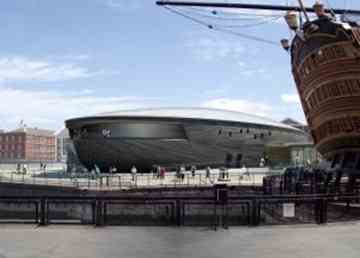Construction has begun on the new Mary Rose Museum in Portsmouth UK, 28 years to the day after the historic vessel was raised from its watery grave in the Solent.
 The new museum contractor, Portsmouth based Warings Contractors Ltd and services group Bouygues have signed a £16.3m contract with the Mary Rose Trust to deliver the construction phase of the £35m project that will secure the future of King Henry VIII’s flagship Mary Rose, which sank in action in 1545.
The new museum contractor, Portsmouth based Warings Contractors Ltd and services group Bouygues have signed a £16.3m contract with the Mary Rose Trust to deliver the construction phase of the £35m project that will secure the future of King Henry VIII’s flagship Mary Rose, which sank in action in 1545.
Rear Admiral John Lippiett, chief executive at the Mary Rose Trust called it, ‘The most ambitious heritage construction project in Europe this decade’.
Work has commenced thanks to the generous support of the Heritage Lottery Fund, corporate and private organisations, and the Mary Rose Trust’s public appeal called the Mary Rose 500.
Fundraising by the Mary Rose Trust is ongoing, with a further £4m still needed to complete the ambitious project. The Trust is tasked with raising a total of £14m to match the £21m Heritage Lottery Fund grant, in order to release those funds.
John Lippiett continued, ‘This is a wonderfully exciting day for the Mary Rose Trust, it’s a major milestone for us. We are embarking on one of the largest heritage projects underway in the world, which is an exciting and daunting task.
‘We still have £4m left to raise and it is our public appeal, the work done by the staff, volunteers and the general public which will make this museum happen. One year on since the launch of the Mary Rose Public Appeal we remain reliant on the public to continue to ensure this national treasure is preserved for future generations.’
Contractor Warings Ltd, is no stranger to refurbishment at Portsmouth’s Naval Dockyard. It is not their first construction project at the facility although they say it is certainly their biggest.
Philippe Jouy, MD at Warings Ltd said, ‘We are delighted to have won the contract to construct the new Mary Rose Museum. We’re extremely proud to be involved and have a very good working relationship with the Mary Rose Trust.
‘This is a unique project which will pose some unique challenges for our dedicated team. Not least is the immense care required to build a modern museum around the precious timbers of the ship as the final stages of its conservation continues. We are well equipped with the necessary skills and expertise and are proud to be leading this landmark development to protect and preserve a British historic icon.’
‘We aim to complete the first phase of construction, completion of the foundations, by Christmas 2010.’
The building work is a major step in the final chapter in the conservation of the great ship. The museum, scheduled for completion in autumn 2012, will reunite the Mary Rose with the majority of the 19,000 well preserved artefacts recovered with it, to present visitors with an unparalleled experience of Tudor life.
The museum is designed by Wilkinson Eyre Architects who are responsible for the design of the Gateshead Millenium Bridge in Newcastle, the Liverpool Arena and Convention Centre and Kings Waterfront Project in Liverpool. The new building housing the Mary Rose’s fully conserved hull and its artefacts will take the form of a finely crafted wooden ‘jewellery box’, clad in timber planks. It will replace the current temporary museum located 300m away, which has space to display only one twentieth of the Tudor items recovered with the wreck.
During the construction of the new museum the Mary Rose is out of view to the public. When the new museum opens in 2012, the preserving chemical sprays that keep it shrouded in mist will be gone. The ship will be on display during the final phase of conservation, controlled air drying, until 2016 when the 34 year conservation process will be complete.
The existing Mary Rose Museum remains open during construction, offering an outstanding visitor experience, with more than 1,000 of the finest conserved artefacts recovered from the site. For further information visit: www.maryrose.org To support the new museum, visit the appeal website: www.maryrose500.org
Source: Maritime Journal [October 12, 2010]